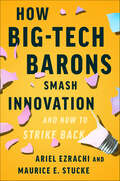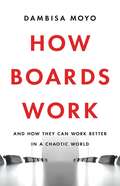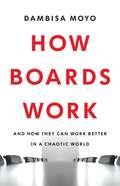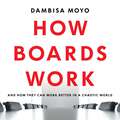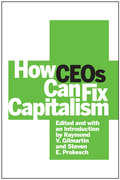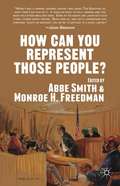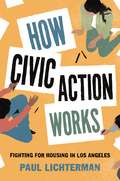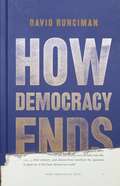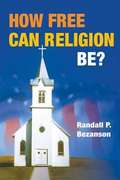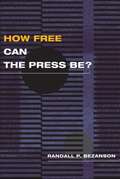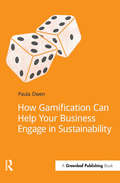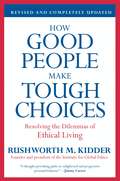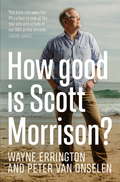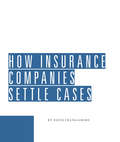- Table View
- List View
How Big-Tech Barons Smash Innovation—and How to Strike Back
by Ariel Ezrachi Maurice E. StuckeTwo market experts deconstruct the drivers and inhibitors to innovation in the digital economy, explain how large tech companies can stifle disruption, assess the toll of their technologies on our well-being and democracy, and outline policy changes to take power away from big tech and return it to entrepreneurs.Silicon Valley’s genius combined with limited corporate regulation promised a new age of technological innovation in which entrepreneurs would create companies that would in turn fuel unprecedented job growth. Yet disruptive innovation has stagnated even as the five leading tech giants, which account for approximately 25 percent of the S&P 500’s market capitalization, are expanding to unimaginable scale and power. In How Big-Tech Barons Smash Innovation—and How to Strike Back, Ariel Ezrachi and Maurice E. Stucke explain why this is happening and what we can do to reverse it.While many distrust the Big-Tech Barons, the prevailing belief is that innovation is thriving online. It isn’t. Rather than disruptive innovations that create significant value, we are getting technologies that primarily extract value and reduce well-being. Using vivid examples and relying on their work in the field, the authors explain how the leading tech companies design their sprawling ecosystems to extract more profits (while crushing any entrepreneur that poses a threat). As a result, we get less innovation that benefits us and more innovations that surpass the dreams of yesteryears’ autocracies. The Tech Barons’ technologies, which seek to decode our emotions and thoughts to better manipulate our behavior, are undermining political stability and democracy while fueling tribalism and hate.But it’s not hopeless. The authors reveal that sustained innovation scales with cities not companies, and that we, as a society, should profoundly alter our investment strategy and priorities to certain entrepreneurs (“Tech Pirates”) and cities’ infrastructure.
How Boards Work: And How They Can Work Better in a Chaotic World
by Dambisa MoyoA New York Times bestselling author and veteran board member offers an insider's view of corporate boards, their struggles, and why they must adapt to survive. Corporate boards are under great pressure. Scandals and malpractice at companies like Theranos, WeWork, Uber, and Wells Fargo have raised justified questions among regulators, shareholders, and the public about the quality of corporate governance. In How Boards Work, prizewinning economist and veteran board director Dambisa Moyo offers an insider's view of corporate boards as they are buffeted by the turbulence of our times. Moyo argues that corporations need boards that are more transparent, more knowledgeable, more diverse, and more deeply involved in setting the strategic course of the companies they lead. How Boards Work offers a road map for how boards can steer companies through tomorrow's challenges and ensure they thrive to benefit their employees, shareholders, and society at large.
How Boards Work: And How They Can Work Better in a Chaotic World
by Dambisa Moyo'Highly instructive . . . provides thoughtful analysis' Financial Times'Exactly what any prospective-or sitting-board member needs' Arianna Huffington'A must read . . . highly engaging . . . an indispensable guide to how boards function, malfunction, and, most importantly, should operate better' Mohamed A. El-ErianCorporate boards are under great pressure. Scandals and malpractice at companies like GE, Theranos and WeWork have raised justified questions among regulators, shareholders, and the public about the quality of corporate governance. Boards face ever-louder demands to weigh in on questions of climate change, racial and gender equity, data privacy, and other social issues that range far beyond their traditional mandate: choosing the CEO and endorsing corporate strategy.In HOW BOARDS WORK, prizewinning economist, veteran board director, and bestselling author Dambisa Moyo offers an insider's view of corporate boards as they are buffeted by the turbulence of our times. Drawing on her decade of experience serving on corporate boards, Moyo lays out what it is that boards actually do, and she outlines how they must adapt to survive the challenges of coming years. Corporations need boards that are more transparent, more knowledgeable, more diverse, and more deeply involved in setting the strategic course of the companies they lead.HOW BOARDS WORK is an urgent road map for how boards can steer companies through tomorrow's challenges and ensure they thrive to benefit their employees, shareholders, and society at large.
How Boards Work: And How They Can Work Better in a Chaotic World
by Dambisa Moyo'Highly instructive . . . provides thoughtful analysis' Financial Times'Exactly what any prospective-or sitting-board member needs' Arianna Huffington'A must read . . . highly engaging . . . an indispensable guide to how boards function, malfunction, and, most importantly, should operate better' Mohamed A. El-ErianCorporate boards are under great pressure. Scandals and malpractice at companies like GE, Theranos and WeWork have raised justified questions among regulators, shareholders, and the public about the quality of corporate governance. Boards face ever-louder demands to weigh in on questions of climate change, racial and gender equity, data privacy, and other social issues that range far beyond their traditional mandate: choosing the CEO and endorsing corporate strategy.In HOW BOARDS WORK, prizewinning economist, veteran board director, and bestselling author Dambisa Moyo offers an insider's view of corporate boards as they are buffeted by the turbulence of our times. Drawing on her decade of experience serving on corporate boards, Moyo lays out what it is that boards actually do, and she outlines how they must adapt to survive the challenges of coming years. Corporations need boards that are more transparent, more knowledgeable, more diverse, and more deeply involved in setting the strategic course of the companies they lead.HOW BOARDS WORK is an urgent road map for how boards can steer companies through tomorrow's challenges and ensure they thrive to benefit their employees, shareholders, and society at large.
How CEOs Can Fix Capitalism
by Steven E. Prokesch Raymond V. GilmartinThe financial crisis of 2008 and the Great Recession caused a crisis of public confidence in business and American-style capitalism, with its focus on maximizing shareholder value. Corporate leaders understood that reform was needed and that they needed to commit themselves to the dual goal of producing benefits for society and their firms' bottom lines-to creating "shared value." But the specific actions they could take to bring about this change were less clear. This ebook offers some of the freshest thinking today on practical measures that businesses can implement to create shared value. Originally published in an online forum hosted by Harvard Business Review, it offers valuable advice about how CEOs, other senior executives, and boards of directors can work together to engage stakeholders in new ways, change their companies' values, build healthier relationships with investors, revamp incentive systems to create long-term value, and develop stronger succession plans.The authors of this collection of short articles include current or former CEOs, such as Howard Schultz of Starbucks and Dominic Barton of McKinsey & Company, and an array of prominent academics and other thought leaders, including Roger Martin of the University of Toronto, Jeffrey Pfeffer of Stanford, and Alfred Rappaport of Northwestern.Its editors are Raymond Gilmartin, the former CEO of Merck and, until recently, an adjunct professor at Harvard Business School, and Steve Prokesch, a senior editor at Harvard Business Review who previously worked at the New York Times and BusinessWeek magazine. In their introduction, they offer five specific recommendations on how CEOs can restore public faith in capitalism.HBR Singles provide brief yet potent business ideas, in digital form, for today's thinking professional.
How Can You Defend Those People?
by Mickey ShermanIn the tradition of true crime bestsellers by Alan Dershowitz and Dominick Dunne, Mickey Sherman delivers a powerful and extraordinarily candid account of his legal career that gives the readers an all-access backstage pass to not only the sausage factory that is the criminal justice system but the &“big cases&” we have all lived with on TV. Sherman started his career as a public defender, then as a prosecutor, and later became a criminal defense attorney for clients such as Michael Skakel (convicted 27 years after the fact for the murder of Martha Moxley) and Alex Kelly (who, on the eve of his double-rape trial in Darien, fled to Europe for nine years). Sherman&’s work has been groundbreaking and sometimes controversial: the raw Court TV coverage of his successful PTSD defense of a Vietnam veteran charged with murdering an unarmed man over a parking space argument was nominated for a Cable Ace Award. When, after a mistrial due to a hung jury in a rape trial, Sherman hired one of the jurors to be his consultant in the retrial of the client, the New York Times declared he had &“undercut the entire jury system.&” A law was soon passed in Connecticut making Sherman&’s move a misdemeanor.This is both an entertaining account of how a successful attorney deals with impossible cases and clients and boldly challenges accepted laws and conventional tactics, as well as a voyeuristic glimpse into the real lives and travails of clients who represent a fascinating cross section of life.
How Can You Represent Those People?
by Abbe Smith Monroe H. FreedmanHow Can You Represent Those People? is the first-ever collection of essays offering a response to the 'Cocktail Party Question' asked of every criminal lawyer. Contributors include prominent lawyers and rising stars, each offering a different often very personal perspective on the Question. Many share stories comic and tragic, inspiring and heartbreaking about criminal defense. Contributors include public defenders, capital defenders, prisoners' rights lawyers, and academics. Essays discuss clients ranging widely from 'ordinary' indigent defendants to alleged terrorists. This is a fascinating collection, a must-read for anyone interested in race, poverty, crime, punishment, and what makes lawyers tick. "
How Civic Action Works: Fighting for Housing in Los Angeles (Princeton Studies in Cultural Sociology #9)
by Paul LichtermanThe ways that social advocates organize to fight unaffordable housing and homelessness in Los Angeles, illuminated by a new conceptual framework for studying collective actionHow Civic Action Works renews the tradition of inquiry into collective, social problem solving. Paul Lichterman follows grassroots activists, nonprofit organization staff, and community service volunteers in three coalitions and twelve organizations in Los Angeles as they campaign for affordable housing, develop new housing, or address homelessness. Lichterman shows that to understand how social advocates build their campaigns, craft claims, and choose goals, we need to move beyond well-established thinking about what is strategic.Lichterman presents a pragmatist-inspired sociological framework that illuminates core tasks of social problem solving, both contentious and noncontentious, by grassroots and professional advocates alike. He reveals that advocates’ distinct styles of collective action produce different understandings of what is strategic, and generate different dilemmas for advocates because each style accommodates varying social and institutional pressures. We see, too, how patterns of interaction create a cultural filter that welcomes some claims about housing problems while subordinating or delegitimating others. These cultural patterns help solve conceptual and practical puzzles, such as why coalitions fragment when members agree on many things, and what makes advocacy campaigns separate housing from homelessness or affordability from environmental sustainability. Lichterman concludes by turning this action-centered framework toward improving dialogue between social advocates and researchers.Using extensive ethnography enriched by archival evidence, How Civic Action Works explains how advocates meet the relational and rhetorical challenges of collective action.
How Civility Works
by Keith BybeeIs civility dead? Americans ask this question every election season, but their concern is hardly limited to political campaigns. Doubts about civility regularly arise in just about every aspect of American public life. Rudeness runs rampant. Our news media is saturated with aggressive bluster and vitriol. Our digital platforms teem with expressions of disrespect and trolls. Reflecting these conditions, surveys show that a significant majority of Americans believe we are living in an age of unusual anger and discord. Everywhere we look, there seems to be conflict and hostility, with shared respect and consideration nowhere to be found. In a country that encourages thick skins and speaking one's mind, is civility even possible, let alone desirable? In How Civility Works, Keith J. Bybee elegantly explores the "crisis" in civility, looking closely at how civility intertwines with our long history of boorish behavior and the ongoing quest for pleasant company. Bybee argues that the very features that make civility ineffective and undesirable also point to civility's power and appeal. Can we all get along? If we live by the contradictions on which civility depends, then yes, we can, and yes, we should.
How Commerce Became Legal: Merchants and Market Governance in Nineteenth-Century Egypt
by Omar Youssef ChetaWhen Egypt's markets opened to private capital in the 1840s, a new infrastructure of commercial laws and institutions emerged. Egypt became the site of profound legal experimentation, and the resulting commercial sphere reflected the political contestations among the governors of Egypt, European consulates, Ottoman rulers, and a growing number of private entrepreneurs, both foreign and local. How Commerce Became Legal explores the legal and business practices that resulted from this fusion of Ottoman, French, and Islamic legal concepts and governed commerce in Egypt. Focusing on the decades between the formalization of Cairo's practical autonomy within the Ottoman Empire in the 1840s and its incorporation into the British Empire in the 1880s, Omar Cheta considers how modern laws redefined the commercial sphere, shaping a mode of market governance that would persist for decades to come. He highlights the demarcation of a new law-defined commercial realm separate from the land regime and from civil or family-centered exchanges, and reconstructs these changes through both legal codes and state orders, as well as individual merchant voices preserved in court documents. As this book documents both individual experiences and structural explanations, it offers a rare perspective on the scope and reach of market governance over the mid nineteenth century, revealing changes simultaneously from within and without state institutions.
How Democracy Ends
by David RuncimanHow will democracy end? And what will replace it? A preeminent political scientist examines the past, present, and future of an endangered political philosophySince the end of World War II, democracy's sweep across the globe seemed inexorable. Yet today, it seems radically imperiled, even in some of the world's most stable democracies. How bad could things get?In How Democracy Ends, David Runciman argues that we are trapped in outdated twentieth-century ideas of democratic failure. By fixating on coups and violence, we are focusing on the wrong threats. Our societies are too affluent, too elderly, and too networked to fall apart as they did in the past. We need new ways of thinking the unthinkable--a twenty-first-century vision of the end of democracy, and whether its collapse might allow us to move forward to something better.A provocative book by a major political philosopher, How Democracy Ends asks the most trenchant questions that underlie the disturbing patterns of our contemporary political life.
How Democratic Is the American Constitution?
by Robert A. DahlDahl starts with the assumption that the legitimacy of the American Constitution derives solely from its utility as an instrument of democratic governance. Dahl demonstrates that, due to the context in which it was conceived, our Constitution came to incorporate significant antidemocratic elements. Because the Framers of the Constitution had no relevant example of a democratic political system on which to model the American government, many defining aspects of our political system were implemented as a result of short-sightedness or last-minute compromise.
How Failed Attempts to Amend the Constitution Mobilize Political Change
by Roger C. HartleySince the Constitution's ratification, members of Congress, following Article V, have proposed approximately twelve thousand amendments, and states have filed several hundred petitions with Congress for the convening of a constitutional convention. Only twenty-seven amendments have been approved in 225 years. Why do members of Congress continue to introduce amendments at a pace of almost two hundred a year?This book is a demonstration of how social reformers and politicians have used the amendment process to achieve favorable political results even as their proposed amendments have failed to be adopted. For example, the ERA "failed" in the sense that it was never ratified, but the mobilization to ratify the ERA helped build the feminist movement (and also sparked a countermobilization). Similarly, the Supreme Court's ban on compulsory school prayer led to a barrage of proposed amendments to reverse the Court. They failed to achieve the requisite two-thirds support from Congress, but nevertheless had an impact on the political landscape. The definition of the relationship between Congress and the President in the conduct of foreign policy can also be traced directly to failed efforts to amend the Constitution during the Cold War.Roger Hartley examines familiar examples like the ERA, balanced budget amendment proposals, and pro-life attempts to overturn Roe v. Wade, but also takes the reader on a three-century tour of lesser-known amendments. He explains how often the mere threat of calling a constitutional convention (at which anything could happen) effected political change.
How Failed Attempts to Amend the Constitution Mobilize Political Change
by Roger C. HartleySince the Constitution's ratification, members of Congress, following Article V, have proposed approximately twelve thousand amendments, and states have filed several hundred petitions with Congress for the convening of a constitutional convention. Only twenty-seven amendments have been approved in 225 years. Why do members of Congress continue to introduce amendments at a pace of almost two hundred a year? This book is a demonstration of how social reformers and politicians have used the amendment process to achieve favorable political results even as their proposed amendments have failed to be adopted. For example, the ERA "failed" in the sense that it was never ratified, but the mobilization to ratify the ERA helped build the feminist movement (and also sparked a countermobilization). Similarly, the Supreme Court's ban on compulsory school prayer led to a barrage of proposed amendments to reverse the Court. They failed to achieve the requisite two-thirds support from Congress, but nevertheless had an impact on the political landscape. The definition of the relationship between Congress and the President in the conduct of foreign policy can also be traced directly to failed efforts to amend the Constitution during the Cold War. Roger Hartley examines familiar examples like the ERA, balanced budget amendment proposals, and pro-life attempts to overturn Roe v. Wade, but also takes the reader on a three-century tour of lesser-known amendments. He explains how often the mere threat of calling a constitutional convention (at which anything could happen) effected political change.
How Free Can Religion Be?
by Randall P. BezansonRandall P. Bezanson's How Free Can Religion Be? explores the Supreme Court's varied history of interpreting the religious guarantees outlined in the First Amendment. The book discusses eight provocative Supreme Court decisions to track the evolution of Free Exercise and Establishment Clause doctrine, focusing on the court's shift from strict separation of church and state to a position where the government accommodates and even fosters religion. Beginning with samples from the latter half of the nineteenth century, the detailed case studies present new problems and revisit some old ones as well: the purported belief of polygamy in the Mormon Church; state support for religious schools; the teaching of evolution and creationism in public schools; Amish claims for exemption from compulsory education laws; comparable claims for Native American religion in relation to drug laws; and rights of free speech and equal access by religious groups in colleges and public schools.
How Free Can the Press Be?
by Randall P. BezansonIn How Free Can the Press Be? Randall P. Bezanson explores contradictions embedded in understanding press freedom in America by discussing nine of the most pivotal and provocative First Amendment cases in U.S. judicial history.
How Gamification Can Help Your Business Engage in Sustainability
by Paula OwenVirtually unknown just a few years ago, gamification is fast emerging as a user engagement and behaviour change tool that succeeds where other tactics and strategies have failed. It's the new "business tech trend to watch", and is already being tested in a diverse range of sectors.Not only useful for strengthening communication and engagement and as a potent behaviour change agent, it is also being advocated as a uniquely effective tool for stimulating innovative thinking and new ideas. In the environmental sector, "eco-gamification" is showing early promise in sustainable transport, employee engagement, energy and recycling, and its potential for other sectors is clear.This book contains all the information businesses and other organizations need to make an informed decision about whether to adopt gamification as part of their own business and sustainability strategies – and the tools to get started. Owen's expert investigation outlines the latest theory, tactics and strategies, draws together emerging best practice and points to stand-out successes in the health and fitness, medical research, and financial sectors, as well as early successes in "eco-gamification".Whether the people you are engaging are customers, citizens, employees, shareholders, executives or board members, if you're an organization concerned with enhancing environmental sustainability, and you want your efforts to make a real and lasting difference, this book is for you.
How Global Currencies Work: Past, Present, and Future
by Barry Eichengreen Arnaud Mehl Livia ChituA powerful new understanding of global currency trends, including the rise of the Chinese yuanAt first glance, the modern history of the global economic system seems to support the long-held view that the leading world power’s currency—the British pound, the U.S. dollar, and perhaps someday the Chinese yuan—invariably dominates international trade and finance. In How Global Currencies Work, three noted economists provide a reassessment of this history and the theories behind the conventional wisdom.Offering a new history of global finance over the past two centuries, and marshaling extensive new data to test established theories of how global currencies work, Barry Eichengreen, Arnaud Mehl, and Livia Chiţu argue for a new view, in which several national monies can share international currency status, and their importance can change rapidly. They demonstrate how changes in technology and in the structure of international trade and finance have reshaped the landscape of international currencies so that several international financial standards can coexist. They show that multiple international and reserve currencies have in fact coexisted in the pastupending the traditional view of the British pound’s dominance prior to 1945 and the U.S. dollar’s dominance more recently.Looking forward, the book tackles the implications of this new framework for major questions facing the future of the international monetary system, from whether the euro and the Chinese yuan might address their respective challenges and perhaps rival the dollar, to how increased currency competition might affect global financial stability.
How Good People Make Tough Choices Rev Ed: Resolving the Dilemmas of Ethical Living
by Rushworth M. KidderShould you take a much-needed vacation or save money for the kids' education? Protect the endangered owl or maintain jobs for loggers? Have a heart-to-heart with a lying employee or fire him on the spot?All of us face ethical choices. Sometimes they're easy: One side is wrong and the other is right. But how do we handle the really tough "right vs. right" dilemmas, where each side has strong moral arguments and we can't do both? This book helps us build Ethical Fitness®--a values-based decision-making process so definitive that it's now a registered trade mark.Rushworth M. Kidder, founder of the Institute for Global Ethics, teaches us how to think for ourselves in order to resolve ethical dilemmas ranging from the intimately personal to the broadly philosophical. Unique in its approach and rich with illustrative anecdotes--updated with examples of real-world conflicts from today's political realm and from Dr. Kidder's own observations--How Good People Make Tough Choices is an indispensable resource for spotting, understanding, and resolving our toughest decisions.
How Good Policies and Business Ethics Enhance Good Quality of Life
by Alex C. MichalosThis volume provides bridges from the social sciences to business ethics and from the latter to the quality of life, by connecting the research themes of quality of life, social sciences, including public policy-making, and business ethics or corporate responsibility. It builds on the premise that public policy making is essentially a species of good decision making, as explained in the first volume. It shows that, because most developed countries function as market economies whose governments depend on taxation to pay for their services and because a large proportion of government revenue comes from well-regulated, responsible corporations, the quality of people's lives is highly dependent upon good public policies, taxation and business ethics. The volume presents and examines ethical/moral problems arising in market economies since the first century BCE, including the first appearance of the business case for business ethics, fourteen arguments concerning the neglect of business ethics, business ethics issues for the 1990s and beyond, the loyal agent's argument, advertising, the importance of trust, public opinion polling, public program evaluation, and a critique of the relatively new monster of super-capitalism. In addition, it deals with connections among the concepts of efficiency, morality, and rationality related to decision making in general and public policy making in particular. Finally, it explains relationships between outcomes measurement and performance indicators in general and performance-based management in public administration, the taxation of net wealth and financial transactions.
How Good is Scott Morrison?
by Wayne Errington Peter van OnselenWithout fear or favour, How Good is Scott Morrison? examines the trials and tribulations of our 30th prime minister. Investigating Morrison's unlikely rise to the liberal leadership and his miracle electoral win, van Onselen and Errington put his leadership under the spotlight.Covering Morrison's disastrous management of the catastrophic bushfire season that was highlighted by the extraordinary statement, 'I don't hold the hose, mate,' and the decision to holiday while the country burned, How Good is Scott Morrison? shows his resolve and the redemption the government's response to the pandemic brought him.Right now, Scott Morrison seems unassailable and sure to win the next election, but what exactly is his vision for Australia? A pragmatist rather than an ideologue, he is a deeply Pentecostal religious man but he doesn't wear his faith as a badge of honour. So what does he really believe in?When the history of this period is written, Morrison will certainly be seen as an election winner but will he be viewed as having had the courage and vision to change Australia for the better, or the worse?
How Human Rights Can Build Haiti: Activists, Lawyers, and the Grassroots Campaign
by Fran QuigleyA cataclysmic earthquake, revolution, corruption, and neglect have all conspired to strangle the growth of a legitimate legal system in Haiti. But as How Human Rights Can Build Haiti demonstrates, the story of lawyers-activists on the ground should give us all hope. They organize demonstrations at the street level, argue court cases at the international level, and conduct social media and lobbying campaigns across the globe. They are making historic claims and achieving real success as they tackle Haiti's cholera epidemic, post-earthquake housing and rape crises, and the Jean-Claude Duvalier prosecution, among other human rights emergencies in Haiti. The only way to transform Haiti's dismal human rights legacy is through a bottom-up social movement, supported by local and international challenges to the status quo. That recipe for reform mirrors the strategy followed by Mario Joseph, Brian Concannon, and their clients and colleagues profiled in this book. Together, Joseph, Concannon, and their allies represent Haiti's best hope to escape the cycle of disaster, corruption, and violence that has characterized the country's two-hundred-year history. At the same time, their efforts are creating a template for a new and more effective human rights-focused strategy to turn around failed states and end global poverty.
How Human Rights Can Build Haiti: Activists, Lawyers, and the Grassroots Campaign
by Fran QuigleyA cataclysmic earthquake, revolution, corruption, and neglect have all conspired to strangle the growth of a legitimate legal system in Haiti. But as How Human Rights Can Build Haiti demonstrates, the story of lawyers-activists on the ground should give us all hope. They organize demonstrations at the street level, argue court cases at the international level, and conduct social media and lobbying campaigns across the globe. They are making historic claims and achieving real success as they tackle Haiti's cholera epidemic, post-earthquake housing and rape crises, and the Jean-Claude Duvalier prosecution, among other human rights emergencies in Haiti. The only way to transform Haiti's dismal human rights legacy is through a bottom-up social movement, supported by local and international challenges to the status quo. That recipe for reform mirrors the strategy followed by Mario Joseph, Brian Concannon, and their clients and colleagues profiled in this book. Together, Joseph, Concannon, and their allies represent Haiti's best hope to escape the cycle of disaster, corruption, and violence that has characterized the country's two-hundred-year history. At the same time, their efforts are creating a template for a new and more effective human rights-focused strategy to turn around failed states and end global poverty.
How Humans Judge Machines
by Cesar A. Hidalgo Diana Orghiain Jordi Albo Canals Filipa De Almeida Natalia MartinHow people judge humans and machines differently, in scenarios involving natural disasters, labor displacement, policing, privacy, algorithmic bias, and more.How would you feel about losing your job to a machine? How about a tsunami alert system that fails? Would you react differently to acts of discrimination depending on whether they were carried out by a machine or by a human? What about public surveillance? How Humans Judge Machines compares people's reactions to actions performed by humans and machines. Using data collected in dozens of experiments, this book reveals the biases that permeate human-machine interactions. Are there conditions in which we judge machines unfairly? Is our judgment of machines affected by the moral dimensions of a scenario? Is our judgment of machine correlated with demographic factors such as education or gender? César Hidalgo and colleagues use hard science to take on these pressing technological questions. Using randomized experiments, they create revealing counterfactuals and build statistical models to explain how people judge artificial intelligence and whether they do it fairly. Through original research, How Humans Judge Machines bring us one step closer tounderstanding the ethical consequences of AI.
How Insurance Companies Settle Cases
by David FrangiamoreHow Insurance Companies Settle Cases Speed up the processing of your claims and reduce your frustration with insurance companies with How Insurance Companies Settle Cases. Knowing how insurance companies operate can help you obtain fair settlements faster. By learning what counts with the home office and what doesn't, you can present your case in its best light with minimum wasted effort, and make both you and your case stand out. This book gives you insider information that reveals how insurance companies evaluate and negotiate claims. Find answers to these questions: * How do insurance companies value cases? * What do adjusters need to settle a case? * Who makes the real decisions on insurance cases? * How do insurance companies value pre-existing injuries? * How do I prove my client really suffers from a soft tissue injury? * What is the structure of most claims departments? * How do I learn policy limits and get a copy of the insurance policy?
